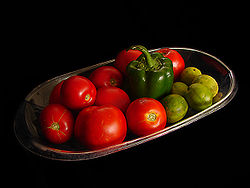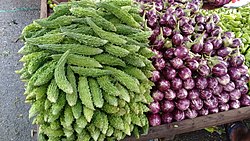Vegetable: Difference between revisions
m robot Adding: is:Grænmeti |
→Fruit, vegetable: info on religion |
||
| Line 7: | Line 7: | ||
Since “vegetable” is not a [[botany|botanical]] term, there is no contradiction in referring to a [[plant]] part as a [[fruit]] while also being considered a vegetable (see diagram). Given this general [[rule of thumb]], vegetables can also include [[leaf vegetable|leaves]] ([[lettuce]]), [[Plant stem|stems]] ([[asparagus]]), [[root vegetable|roots]] ([[carrots]]), [[flowers]] ([[broccoli]]), [[bulb]]s ([[garlic]]), [[seeds]] ([[pea]]s and [[bean]]s) and [[fruit#Botanic fruit and culinary fruit|botanical fruit]]s such as [[cucumber]]s, [[squash (vegetable)|squash]], [[pumpkin]]s, and [[capsicum]]s. Botanically, fruits are reproductive organs (ripened [[Ovary (plants)|ovaries]] containing one or many seeds), while vegetables are vegetative organs which sustain the plant. |
Since “vegetable” is not a [[botany|botanical]] term, there is no contradiction in referring to a [[plant]] part as a [[fruit]] while also being considered a vegetable (see diagram). Given this general [[rule of thumb]], vegetables can also include [[leaf vegetable|leaves]] ([[lettuce]]), [[Plant stem|stems]] ([[asparagus]]), [[root vegetable|roots]] ([[carrots]]), [[flowers]] ([[broccoli]]), [[bulb]]s ([[garlic]]), [[seeds]] ([[pea]]s and [[bean]]s) and [[fruit#Botanic fruit and culinary fruit|botanical fruit]]s such as [[cucumber]]s, [[squash (vegetable)|squash]], [[pumpkin]]s, and [[capsicum]]s. Botanically, fruits are reproductive organs (ripened [[Ovary (plants)|ovaries]] containing one or many seeds), while vegetables are vegetative organs which sustain the plant. |
||
The |
The question "''is it a fruit, or is it a vegetable?''" has even found its way into the [[United States Supreme Court]], which ruled unanimously in ''[[Nix v. Hedden]], [[1883]]'', that a [[tomato]] is a vegetable for the purposes of 1883 Tariff Act, although botanically, a tomato is a fruit. |
||
The distinction between fruits and vegetables is not just semantic. In Judaism, where religious Jews recite a blessing before eating food, and each food group has a separate blessing, defining a food as a fruit or vegetable will affect which blessing is chosen. |
|||
[[Agriculture|Commercial production]] of vegetables is a branch of [[horticulture]] called ''[[olericulture]]''. |
[[Agriculture|Commercial production]] of vegetables is a branch of [[horticulture]] called ''[[olericulture]]''. |
||
Revision as of 11:20, 18 June 2007

Vegetable is a culinary term which generally refers to an edible part of a plant. The definition is traditional rather than scientific and is somewhat arbitrary and subjective. All parts of herbaceous plants eaten as food by humans, whole or in part, are normally considered vegetables. Mushrooms, though belonging to the biological kingdom fungi, are also commonly considered vegetables. In general, vegetables are thought of as being savory, and not sweet, although there are many exceptions. Nuts, grains, herbs, spices and culinary fruits (see below) are normally not considered vegetables.
Fruit, vegetable
Since “vegetable” is not a botanical term, there is no contradiction in referring to a plant part as a fruit while also being considered a vegetable (see diagram). Given this general rule of thumb, vegetables can also include leaves (lettuce), stems (asparagus), roots (carrots), flowers (broccoli), bulbs (garlic), seeds (peas and beans) and botanical fruits such as cucumbers, squash, pumpkins, and capsicums. Botanically, fruits are reproductive organs (ripened ovaries containing one or many seeds), while vegetables are vegetative organs which sustain the plant.
The question "is it a fruit, or is it a vegetable?" has even found its way into the United States Supreme Court, which ruled unanimously in Nix v. Hedden, 1883, that a tomato is a vegetable for the purposes of 1883 Tariff Act, although botanically, a tomato is a fruit.
The distinction between fruits and vegetables is not just semantic. In Judaism, where religious Jews recite a blessing before eating food, and each food group has a separate blessing, defining a food as a fruit or vegetable will affect which blessing is chosen.
Commercial production of vegetables is a branch of horticulture called olericulture.
Etymology
Vegetable is also used as a literary term for any plant: vegetable matter, vegetable kingdom.[1] It comes from Latin vegetabilis (animated) and from vegetare (enliven), which is derived from vegetus (active), in reference to the process of a plant growing. This in turn derives from the Proto-Indo-European base *weg- or *wog-, which is also the source of the English wake, meaning "not sleep". The word vegetable was first recorded in print in English in the 14th century. The meaning of "plant grown for food" was not established until the 18th century. [2]
In the diet
Vegetables are eaten in a variety of ways as part of main meals and as snacks. The nutrient content of different types varies considerably. With the exception of pulses, vegetables provide little protein and fat.[3][4] Vegetables contain water soluble vitamins like vitamin B and vitamin C, fat-soluble vitamins including vitamin A and vitamin D, and also contain carbohydrates and minerals.
Color

The green color of leafy vegetables is due to the presence of the green pigment chlorophyll. Chlorophyll is affected by pH and changes to olive green in acid conditions, and bright green in alkaline conditions. Some of the acids are released in steam during cooking, particularly if cooked without a cover.
The yellow/orange colors of fruits and vegetables are due to the presence of carotenoids, which are also affected by normal cooking processes or changes in pH.
The red/blue coloring of some fruits and vegetables (e.g. blackberries and red cabbage) are due to anthocyanins, which are sensitive to changes in pH. When pH is neutral, the pigments are purple, when acidic, red, and when alkaline, blue. These pigments are very water soluble.
Storage
Many root and non-root vegetables that grow underground can be stored through winter in a root cellar or other similarly cool, dark and dry place to prevent mold, greening and sprouting. Care should be taken in understanding the properties and vulnerabilities of the particular roots to be stored. These vegetables can last through to early spring and be nearly as nutritious as when fresh.
During storage, leafy vegetables lose moisture and vitamin C degrades rapidly. They should be stored for as short a time as possible in a cool place in a container, such as a plastic bag.
See also
Notes
- ^ Swedenborg, Emanuel. (2003) Swedenborg Concordance 1888. Kessinger Publishing. p. 502. ISBN 0-7661-3728-7.
- ^ Ayto, John (1993). Dictionary of Word Origins. New York: Arcade Publishing. ISBN 1-55970-214-1.
- ^ Woodruff, Sandra. (1995) Secrets of Fat-Free Cooking. Avery. p. 85. ISBN 0-89529-668-3.
- ^ Whitaker, Julian. (2001) Reversing Diabetes. Warner Books. pp. 269-71. ISBN 0-446-67658-6.
